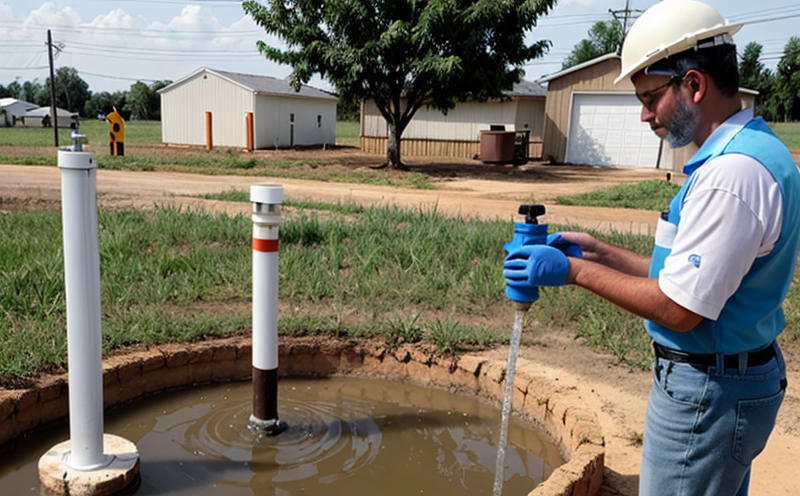EPA Method 300.1 Nitrate, Nitrite, Bromide in Groundwater
The EPA Method 300.1 is a standardized procedure developed by the U.S. Environmental Protection Agency (EPA) to determine concentrations of nitrate, nitrite, and bromide in groundwater. This method employs a combination of sample collection procedures, filtration techniques, and analytical methods designed to ensure accurate and precise results.
The primary purpose of this method is to provide reliable data for monitoring compliance with drinking water regulations set forth by the Safe Drinking Water Act (SDWA). The presence of nitrate and nitrite in groundwater can pose significant health risks, particularly for infants under six months old. Bromide testing provides additional insights into potential contamination sources.
The standard procedure involves several critical steps:
- Sample Collection: Proper collection of the water sample is crucial to avoid contamination and ensure accurate results.
- Filtration: The sample must be filtered through a specific type of filter, such as a 0.45 μm pore size polyethersulfone (PES) membrane filter.
- Precipitation and Extraction: Nitrate and nitrite are precipitated using silver nitrate or zinc acetate, followed by extraction with dichloromethane.
- Analysis: The extracts are analyzed using ion chromatography (IC) to quantify the concentrations of nitrate, nitrite, and bromide.
The method is designed for groundwaters that have a low ionic strength. This ensures that the analytes do not form complexes with other ions present in higher ionic strength solutions, which could lead to inaccurate results.
For accurate analysis, it's essential to follow all prescribed steps meticulously and use appropriate reagents and equipment. The method is optimized for samples with nitrate concentrations up to 10 mg/L, but modifications can be applied for lower or higher concentration ranges.
The EPA Method 300.1 is widely used in environmental monitoring programs, private well testing, and public water supply systems compliance checks. Compliance officers must ensure that all tests are conducted according to the specified method to avoid non-compliance penalties.
| Parameter | Method | Range | Unit |
|---|---|---|---|
| Nitrate (NO₃⁻) | Ion Chromatography | 0.1 - 10 mg/L | mg/L |
| Nitrite (NO₂⁻) | Ion Chromatography | 0.05 - 2 mg/L | mg/L |
| Bromide (Br⁻) | Ion Chromatography | 0.1 - 10 mg/L | mg/L |
The method is sensitive and can detect low concentrations of the target analytes, making it suitable for both routine monitoring and research applications.
Applied Standards
| Standard | Description |
|---|---|
| EPA Method 300.1 | Method for the Determination of Nitrate, Nitrite, and Bromide in Groundwater by Ion Chromatography. |
| ASTM D5948-22 | Standard Practice for Collection and Preservation of Water Samples for Chlorine Analysis. |
| ISO 17025 | General Requirements for the Competence of Testing and Calibration Laboratories. |
The method is rigorously validated against international standards to ensure accuracy, precision, and reliability. Compliance with these standards guarantees that laboratory results are accepted by regulatory bodies worldwide.
Eurolab Advantages
As a leading provider of environmental testing services, Eurolab offers comprehensive groundwater quality testing using EPA Method 300.1. Our team of experts ensures that all tests are conducted in accordance with the latest standards and protocols.
- Accurate Results: Utilizing state-of-the-art instrumentation and experienced personnel, we provide precise measurements essential for regulatory compliance.
- Timely Delivery: We understand the importance of timely results in environmental management. Our streamlined processes ensure that you receive your reports within specified timelines.
- Comprehensive Reporting: Our detailed reports include all necessary data and interpretations, supporting informed decision-making.
- Client Satisfaction: We prioritize customer satisfaction by offering personalized service and transparent communication throughout the testing process.
Our commitment to quality and accuracy is reflected in our robust quality management systems certified to ISO 17025, ensuring that every test we perform meets the highest industry standards.
International Acceptance and Recognition
- EPA Method 300.1 is recognized by numerous global regulatory bodies including the WHO, UNICEF, and national governments.
- The method's use in international studies has contributed to a standardized approach to groundwater quality assessment worldwide.
- Adoption of this method ensures consistent results across different countries and regions, facilitating cross-border collaboration on environmental issues.
This widespread acceptance underscores the importance and reliability of EPA Method 300.1 in global water quality management efforts.





